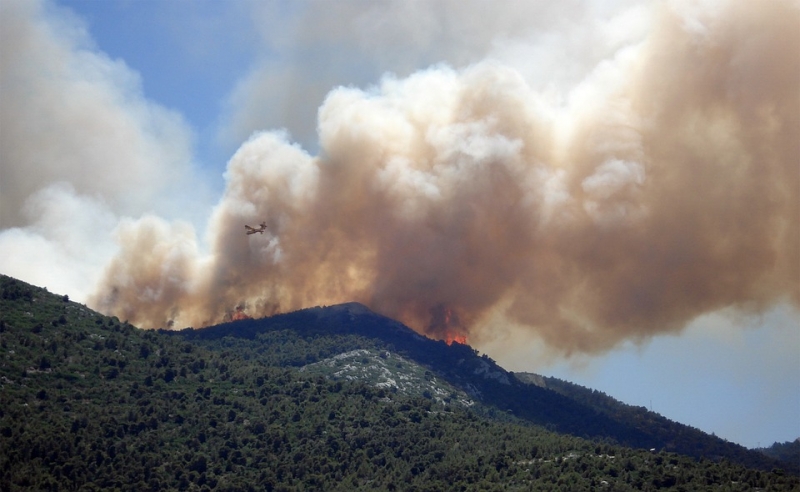Lasting repercussions of the 2018 fire season have continued to vex California’s electric utility sector, the state government, and communities across the state that are recovering from previous fires and bracing for the next wave of wildfires.
PG&E, the bankrupt private electric utility whose aging infrastructure has been linked to 19 major wildfires in 2017 and 2018, has faced withering coverage in the press, intense scrutiny by state officials, and public questioning in federal court. Earlier this month, the Wall Street Journal reported that PG&E has repeatedly delayed updates to its transmission lines and towers, many of which are still in operation well beyond their life expectancy. According to a 2018 company plan for upgrading transmission lines, “[n]early 600 projects, with an estimated $2.7 billion cost, had a higher risk score than” the Caribou-Palermo transmission line, which caused the Camp Fire. After reviewing PG&E inspection documents, the safety and enforcement chief for the California Public Utilities Commission (CPUC), Elizaveta Malashenko, noted that the poor state of the Caribou-Palermo line was not an outlier.
The company acknowledged in its legally mandated wildfire mitigation plan last October that it needed to increase inspections throughout its distribution area and harden its systems. By the end of May, PG&E had inspected and repaired virtually all of its infrastructure in areas of highest fire risk. Despite this progress, the magnitude of the remaining backlog of 3,700 pending repairs calls into question whether these actions can keep pace with future wildfires.
 State officials have expressed hearty skepticism about PG&E’s ability to keep its users safe from wildfires. Gov. Gavin Newsom, who has made wildfire mitigation a priority since taking office in January, chastised the company in May by asserting that it “has not demonstrated that it understands the gravity and urgency of” its bankruptcy and safety concerns. The governor’s office also pushed back on the appointment of PG&E’s new board members in April, criticizing “the large representation of Wall Street interests and most board nominees’ lack of relevant California experience.”
State officials have expressed hearty skepticism about PG&E’s ability to keep its users safe from wildfires. Gov. Gavin Newsom, who has made wildfire mitigation a priority since taking office in January, chastised the company in May by asserting that it “has not demonstrated that it understands the gravity and urgency of” its bankruptcy and safety concerns. The governor’s office also pushed back on the appointment of PG&E’s new board members in April, criticizing “the large representation of Wall Street interests and most board nominees’ lack of relevant California experience.”
Federal Judge William Alsup has also held PG&E to task for its actions. In May, he ordered the company’s board members to visit Paradise to see the destruction caused by Camp Fire. He issued another order in July mandating that the company respond paragraph-by-paragraph to the Wall Street Journal’s findings on the maintenance backlog. Judge Alsup, who oversees PG&E’s probation following the company’s criminal convictions related to a 2010 pipeline explosion, has been a vocal critic of what he sees as the company’s dismal safety practices.
At the state level in California, recommendations from advisory groups and legislative actions have attempted to address the impacts of wildfires. Governor Newsom’s wildfire strike force in April published a report outlining options to prevent catastrophic wildfires and improve emergency response, mitigate underlying climate change, fairly allocate catastrophic wildfire damages, make CPUC more effective, and hold PG&E accountable and more attuned to safety concerns. Governor Newsom earlier this month signed a law that draws from the strike force report and creates a fund to pay out up to $21 billion for wildfire claims, alleviating some of the financial burden from already-stressed electricity utilities. To participate in the fund, major utility companies must spend a combined minimum of $5 billion on safety improvements. Although the legislation drew criticism for not providing relief to victims of previous years’ wildfires, it was recognized as an important step in keeping the state’s utilities afloat.
The Commission on Catastrophic Wildfire Cost and Recovery, legislated into being under then-Gov. Jerry Brown, recently addressed the strain inflicted by California wildfires from an insurance perspective. In its June report, the commission recommended that California reform the Fair Access to Insurance Requirements (FAIR) plan of last resort. In addition, the commission suggested more equitably distributing the burden of wildfire damages by imposing fees on new construction in the wildland-urban interface (WUI) or requiring that homebuyers in the WUI get a fire insurance quote before completing the purchase.
For their part, PG&E and its peers are experimenting with new practices as wildfire season ramps up over the summer. In its wildfire mitigation plan filed with the CPUC, PG&E emphasized the planned expansion of its Public Safety Public Shutoff (PSPS) program, through which it shuts down power lines during periods of high fire risk. PG&E considers a number of factors, including National Weather Service warnings, low humidity levels, intense winds, and dry vegetation, in determining high fire risk. PG&E, Southern California Edison, and San Diego Gas & Electric have increased their public outreach to give consumers advance warnings of shutoffs. Even with this campaign, though, some vulnerable populations, including those that depend on power for at-home medical devices, will be negatively impacted by the wildfire prevention measure.
Homeowners and local officials are also considering ambitious measures to mitigate wildfires, including by going beyond wildfire-prevention housing code requirements and leveraging open space. ELI will survey these more localized mitigation actions in a future blog.
In the months since last fall’s wildfires, California has pushed forward on a number of fronts to address shortcomings in the utility and insurance sectors and to prepare for the next round of wildfires. However, it remains to be seen whether the assertive action will be enough to prevent a continued pattern of wildfire damages and to match the increasing intensity and frequency of fires often driven by a changing climate.

